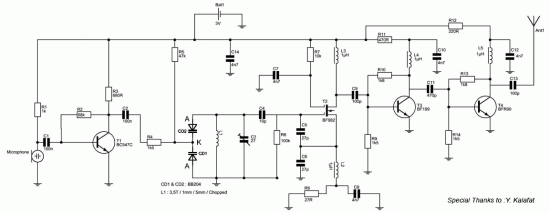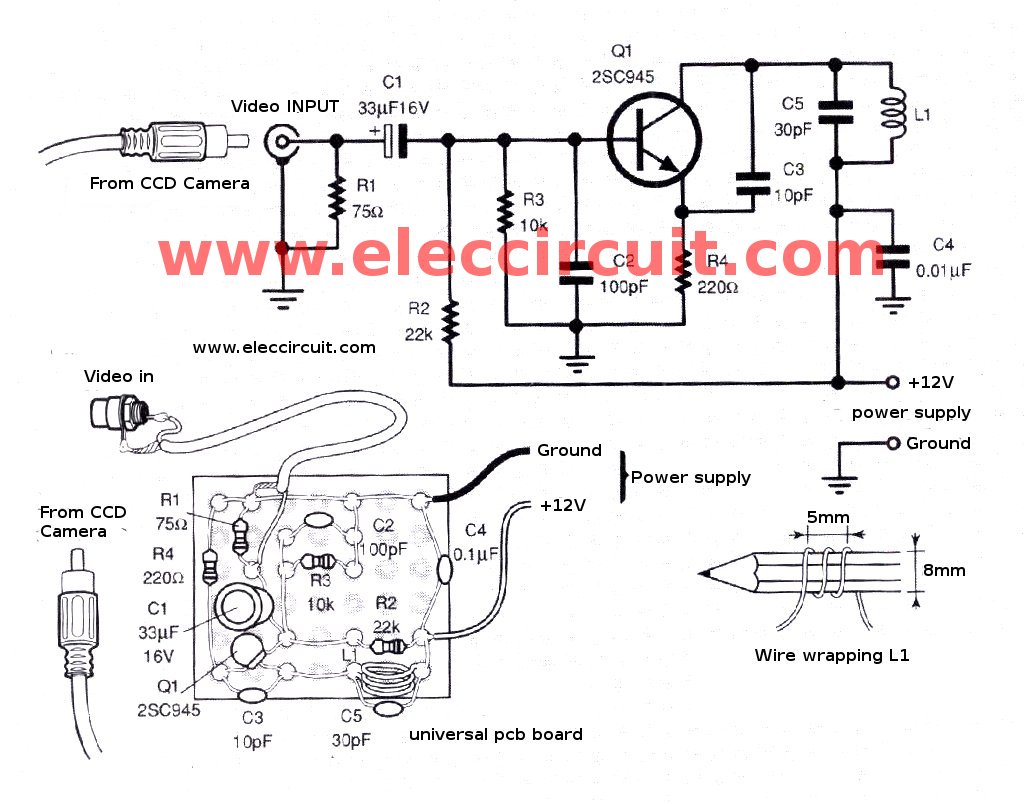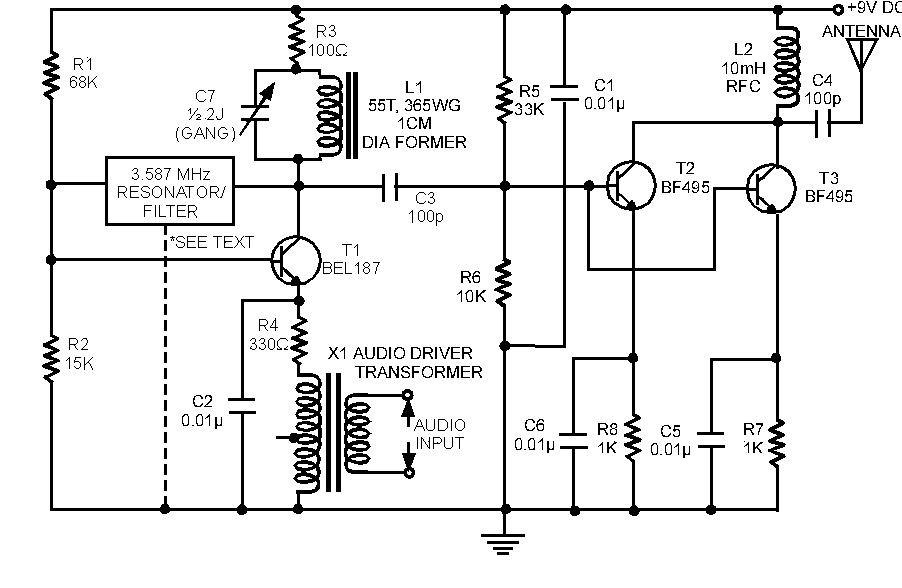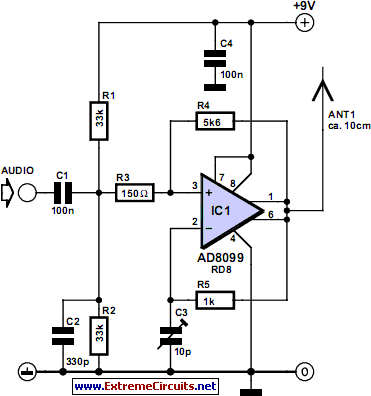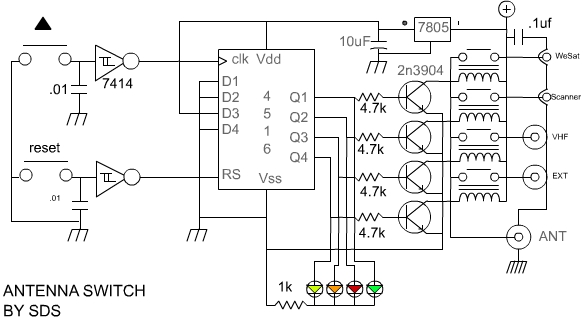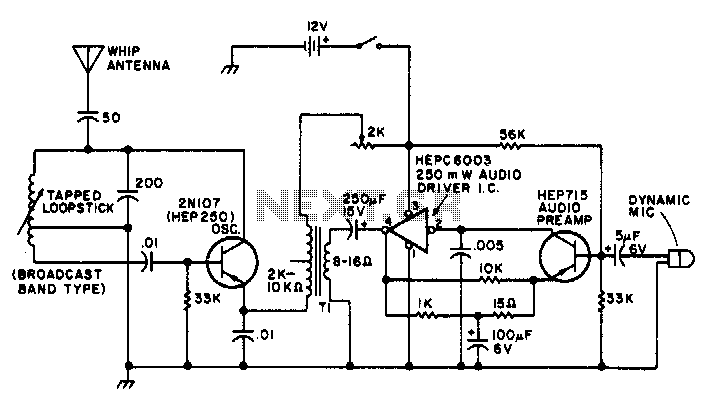
MAX2606 VHF FM Transmitter
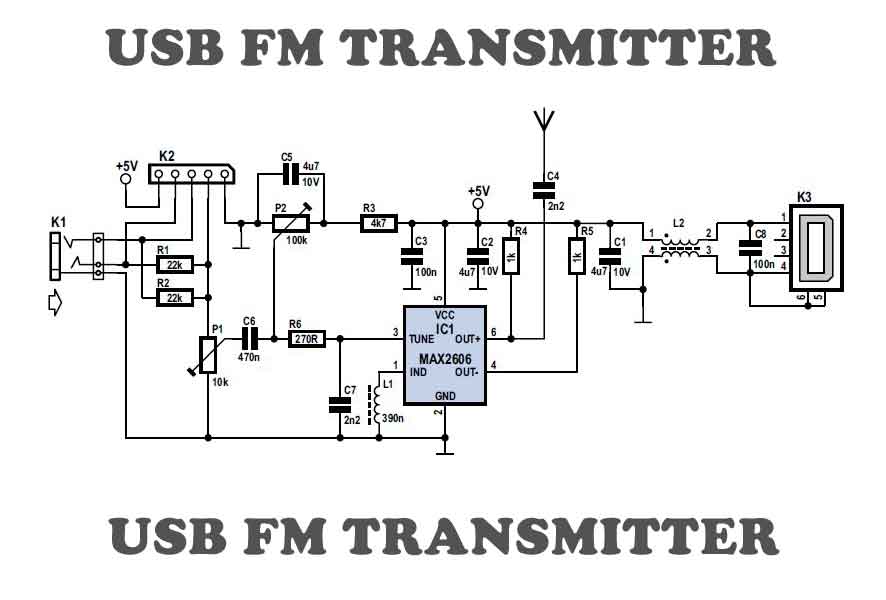
To test VHF receivers independently from local radio stations, a frequency-modulated oscillator is required, covering the range of 89.5 to 108 MHz. Building such an oscillator with discrete components is challenging. The MAX260x series from Maxim offers five integrated oscillator building blocks that span the frequency range of 45 to 650 MHz. An appropriate external coil, designed for the midrange frequency, is also necessary. The MAX2606 specifically operates within the VHF band, but the frequency can only be adjusted by approximately ±3 MHz around the midrange frequency set by the coil L. The inductance values provided in the accompanying table can act as starting points for experimentation. SMD coils from the Stettner 5503 series are suitable for these oscillators, available in Germany from BG Rüklin, with inductance values ranging from 12 nH to 1200 nH. It is possible to achieve any desired inductance by combining two suitable coils. For those interested in winding their own coils, using 8 to 14 turns of 0.5-mm diameter silver-plated copper wire on a 5-mm mandrel is recommended. Fine adjustments to the coil's inductance can be made by slightly spreading or compressing the coil. The circuit operates on a 9-V battery, with the BC238C transistor stabilizing the voltage to approximately 4 V. Although the MAX2606 can function with supply voltages between +2.7 V and +5.5 V, a stabilized voltage enhances the frequency stability of the oscillator. The supply voltage connection (Vcc, pin 5) and the tuning voltage (TUNE, pin 3) should be decoupled using 1-nF capacitors placed as close as possible to the IC pins. The tuning voltage on pin 3 should range from +0.4 V to +2.4 V. The output is symmetric, provided by the OUT+ and OUT pins, which can be used in a single-ended configuration with pull-up resistors connected to each output. A capacitor can be used to extract the radio signal from either of these resistors, with several milliwatts of power available. An audio input signal amplitude of 10 to 20 mV is sufficient to produce the standard VHF frequency deviation of ±40 kHz.
The circuit design centers around the use of the MAX2606 integrated circuit, which simplifies the construction of a frequency-modulated oscillator. The oscillator operates within the VHF frequency range, essential for testing various VHF receivers without reliance on local radio signals. The choice of the external coil is critical, as it directly influences the operational frequency. The MAX2606 requires a coil with an inductance value that can be fine-tuned, allowing for a narrow frequency adjustment of ±3 MHz around the set frequency.
The power supply design incorporates a 9-V battery, with the BC238C transistor serving as a voltage regulator to maintain a stable output of approximately 4 V, thereby ensuring consistent oscillator performance. The use of decoupling capacitors (1 nF) at the power supply and tuning voltage pins is essential for minimizing noise and enhancing frequency stability, which is particularly important in RF applications.
The tuning voltage applied to pin 3 allows for frequency adjustments within a specific range, facilitating the oscillator's adaptability to various testing scenarios. The symmetric output configuration, achieved through the OUT+ and OUT pins, allows for flexibility in signal extraction, with the option to utilize capacitors and pull-up resistors to optimize the output signal for further processing or transmission.
Overall, this oscillator circuit is a robust solution for VHF receiver testing, providing essential frequency modulation capabilities while allowing for user-defined adjustments through external components. The design's emphasis on stability and adaptability makes it a valuable tool in RF engineering and testing applications.To be independent of the local radio stations for testing VHF receivers, you need a frequency-modulated oscillator that covers the range of 89. 5 to 108 MHz ” but building such an oscillator using discrete components is not that easy. Maxim now has available a series of five integrated oscillator building blocks in the MAX260x serieswhich cover the frequency range between 45
and 650 MHz. The only other thing you need is a suitable external coil, dimensioned for the midrange frequency. The MAX2606 covers the VHF band, although the frequency can only be varied by approximately ±3 MHz around the midrange frequency set by the coil L. The inductance values shown in the table can serve as starting points for further experimenting. The SMD coils of the Stettner 5503 series are suitable for such oscillators. In Germany, they are available from BG rklin ( with values between 12 nH and 1200 nH. You can thus directly put together any desired value using two suitable coils. If you want to wind your own coils, try using 8 to 14 turns of 0. 5-mm diameter silver-plated copper wire on a 5-mm mandrel. You can make fine adjustments to the inductance of the coil by slightly spreading or compressing the coil.
The circuit draws power from a 9-V battery. The BC238C stabilises the voltage to approximately 4 V. Although the MAX2606 can work with a supply voltage between +2. 7 V and +5. 5 V, a stabilised voltage improves the frequency stability of the free-running oscillator. The supply voltage connection Vcc (pin 5) and the TUNE voltage (pin 3) must be decoupled by 1-nF capacitors located as close as possible to the IC pins. The tuning voltage TUNE on pin 3 may lie between +0. 4 V and +2. 4 V. A symmetric output is provided by the OUT+ and OUT pins. In the simplest case, the output can be used in a single-ended configuration. Pull-up resistors are connected to each of the outputs for this purpose. You can use a capacitor to tap off the radio signal from either one of these resistors. Several milliwatts of power are available. At the audio input, a signal amplitude of 10 to 20 mV is enough to generate the standard VHF frequency deviation of ±40 kHz.
🔗 External reference
The circuit design centers around the use of the MAX2606 integrated circuit, which simplifies the construction of a frequency-modulated oscillator. The oscillator operates within the VHF frequency range, essential for testing various VHF receivers without reliance on local radio signals. The choice of the external coil is critical, as it directly influences the operational frequency. The MAX2606 requires a coil with an inductance value that can be fine-tuned, allowing for a narrow frequency adjustment of ±3 MHz around the set frequency.
The power supply design incorporates a 9-V battery, with the BC238C transistor serving as a voltage regulator to maintain a stable output of approximately 4 V, thereby ensuring consistent oscillator performance. The use of decoupling capacitors (1 nF) at the power supply and tuning voltage pins is essential for minimizing noise and enhancing frequency stability, which is particularly important in RF applications.
The tuning voltage applied to pin 3 allows for frequency adjustments within a specific range, facilitating the oscillator's adaptability to various testing scenarios. The symmetric output configuration, achieved through the OUT+ and OUT pins, allows for flexibility in signal extraction, with the option to utilize capacitors and pull-up resistors to optimize the output signal for further processing or transmission.
Overall, this oscillator circuit is a robust solution for VHF receiver testing, providing essential frequency modulation capabilities while allowing for user-defined adjustments through external components. The design's emphasis on stability and adaptability makes it a valuable tool in RF engineering and testing applications.To be independent of the local radio stations for testing VHF receivers, you need a frequency-modulated oscillator that covers the range of 89. 5 to 108 MHz ” but building such an oscillator using discrete components is not that easy. Maxim now has available a series of five integrated oscillator building blocks in the MAX260x serieswhich cover the frequency range between 45
and 650 MHz. The only other thing you need is a suitable external coil, dimensioned for the midrange frequency. The MAX2606 covers the VHF band, although the frequency can only be varied by approximately ±3 MHz around the midrange frequency set by the coil L. The inductance values shown in the table can serve as starting points for further experimenting. The SMD coils of the Stettner 5503 series are suitable for such oscillators. In Germany, they are available from BG rklin ( with values between 12 nH and 1200 nH. You can thus directly put together any desired value using two suitable coils. If you want to wind your own coils, try using 8 to 14 turns of 0. 5-mm diameter silver-plated copper wire on a 5-mm mandrel. You can make fine adjustments to the inductance of the coil by slightly spreading or compressing the coil.
The circuit draws power from a 9-V battery. The BC238C stabilises the voltage to approximately 4 V. Although the MAX2606 can work with a supply voltage between +2. 7 V and +5. 5 V, a stabilised voltage improves the frequency stability of the free-running oscillator. The supply voltage connection Vcc (pin 5) and the TUNE voltage (pin 3) must be decoupled by 1-nF capacitors located as close as possible to the IC pins. The tuning voltage TUNE on pin 3 may lie between +0. 4 V and +2. 4 V. A symmetric output is provided by the OUT+ and OUT pins. In the simplest case, the output can be used in a single-ended configuration. Pull-up resistors are connected to each of the outputs for this purpose. You can use a capacitor to tap off the radio signal from either one of these resistors. Several milliwatts of power are available. At the audio input, a signal amplitude of 10 to 20 mV is enough to generate the standard VHF frequency deviation of ±40 kHz.
🔗 External reference
